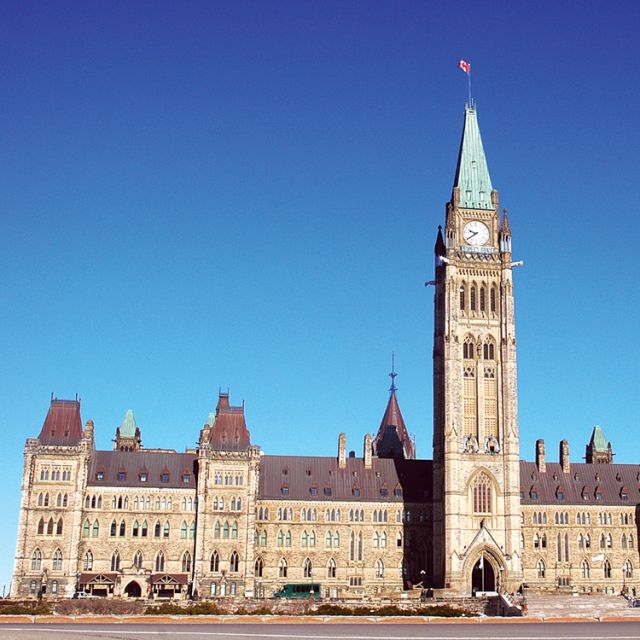Later that week, both Speakers hosted a lunch in honour of the new cardinal from Toronto, Cardinal Thomas Collins — this time the meal was held on the Senate side. It spoke well of our chief parliamentary officers, not only as a point of pride for us Catholics, but also because the visits manifested that our constitutional system of Crown-in-Parliament recognizes the necessary contribution of civil society to the common good, at the heart of which are a country’s religious institutions. In short, it’s good for politics to recognize that politics is not everything, and that many good things are beyond the reach of politics to achieve.
An unexpected grace of the visits was seeing the buildings through fresh eyes — in this case, those of a Catholic visitor from India. Cardinal Gracias commented several times on what he clearly saw as the religious character of our Parliament buildings. Most notable was the Gothic style and the “cathedral” shaped windows that one most often sees in cathedrals, like our own in Kingston. The layout of the two chambers — a great chair (cathedra) at the end of rows of desks set out in choral style, facing each other, calls to mind a typical abbey configuration. And, the cardinal noted with a smile, the Westminster colour scheme also echoed ecclesiastical practice. There is the green chamber (Commons) and the red chamber (Senate), even as in the Catholic Church green is the heraldic colour for bishops, red for cardinals.
It shouldn’t be a surprise. Parliamentary government has deep roots in the Church history of Christian cultures. At the mother of all parliaments in London, the Palace of Westminster originally had no proper place for a Commons chamber, so the chapter house of Westminster Abbey across the street was used for parliamentary proceedings. This was not merely a matter of logistical need, but it recognized that the roots of representative democratic government grew out of the governance practice of the religious orders and their abbeys. The abbot and chapter provided an early model for the Crown-in-Parliament. Indeed, the King’s Great Council first met in the chapter house in 1257, the effective beginning of parliamentary government.
The historic importance of the chapter house is reflected in the central rotunda of our Ottawa buildings, which takes its octagonal shape and vaulted ceilings from the Westminster Abbey birthplace of parliament.
At Westminster itself, the equivalent Central Lobby is also octagonal in shape, and is decorated by four mosaics representing the nations of the United Kingdom — England, Scotland, Wales and Northern Ireland. How are the four nations represented? By their patrons: St. George, St. Andrew, St. David and St. Patrick.
The most prominent part of our Parliament buildings, the Peace Tower, contains in its heart the Memorial Chamber, which is a chapel of remembrance to the fallen in the First World War. Outside, the three arches of the Peace Tower entrance are engraved with biblical verses in stone: He shall have dominion from sea to sea (Psalm 72:8); Give the king thy judgments, O God, and righteousness unto the king’s son (Psalm 72:1); Where there is no vision, the people perish (Proverbs 29:18).
Another notable biblical inscription is over the meeting room of the shadow cabinet. It reads: Fear God, Honour the king (1 Peter 2:17). An act of piety? Perhaps, but it was put there by Prime Minister Mackenzie King at the time when the cabinet used to meet in that room. Which “king” was to be honoured by the ministers?
In the East Block is a proper chapel, used regularly for Bible studies and occasionally for Mass. The chapel is named in honour of Fr. Sean O’Sullivan, the former MP who became a priest. He died in 1989 and the chapel was dedicated soon after.
The Parliament buildings are meant to tell the story of the nation, and that story is not exclusively one of politics. During cardinals’ week on the Hill, it was more evident than usual.
A nation’s story is not told only in politics
By Fr. Raymond J. de SouzaOTTAWA - About a month ago it was cardinals’ week here in the nation’s capital. Our chaplaincy at Queen’s University was hosting the visit to Canada of the archbishop of Bombay, Cardinal Oswald Gracias. Given that it was his first visit to our country, and that he was flying into Ottawa, it was arranged that he would visit Parliament. The Speaker of the Senate, Noel Kinsella, received him and gave him a tour of the red chamber and the speaker’s offices. Afterward, the Speaker of the House of Commons, Andrew Scheer, hosted a dinner in Cardinal Gracias’ honour.
Please support The Catholic Register
Unlike many media companies, The Catholic Register has never charged readers for access to the news and information on our website. We want to keep our award-winning journalism as widely available as possible. But we need your help.
For more than 125 years, The Register has been a trusted source of faith-based journalism. By making even a small donation you help ensure our future as an important voice in the Catholic Church. If you support the mission of Catholic journalism, please donate today. Thank you.
DONATE

